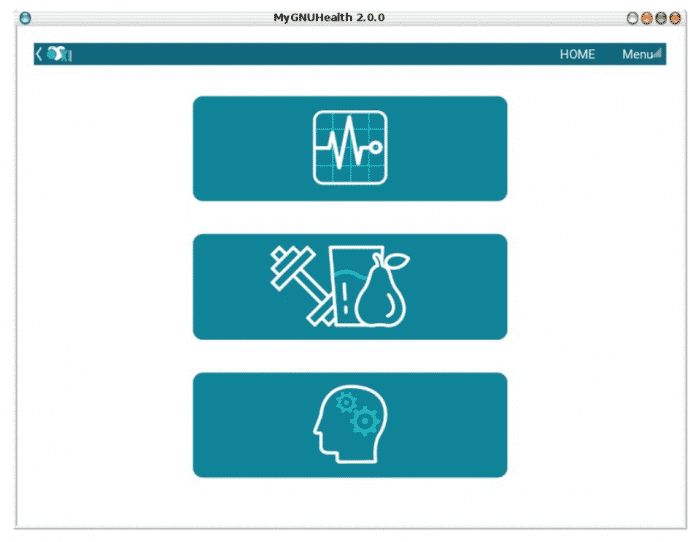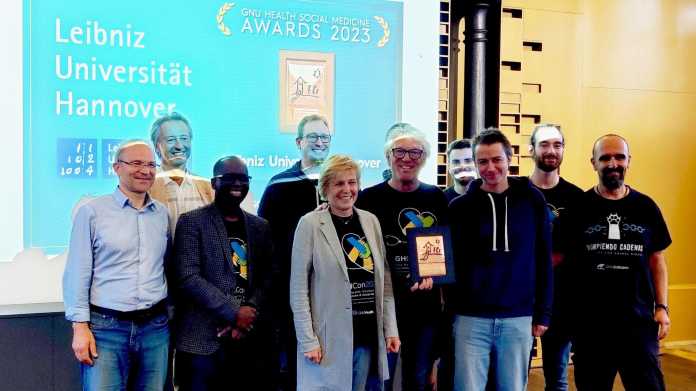GNU Health Conference: Free software for personal health records and more
In addition to the electronic health record ‘MyGNUHealth’, numerous other possible uses of free software in the medical field were presented at the conference.

The University of Hanover not only hosts this year's GNU Health Conference, but also received a Social Medicine Award for its active support of the GNU Health Project.
(Hier finden Sie die deutsche Version des Beitrags)
At the international GNU Health Conference (GHCon) in Hanover, participants of the GNU Health Community and the OrthancCon discussed areas of application for free software in health care as well as developments for the free DICOM server 'Orthanc'. The conference was organized by a team around Professor Gabriele von Voigt from the Department of Computational Health Informatics at Leibniz University, Hanover. Presentations highlighted GNU Health projects from numerous countries, the release of the personal health record MyGNUHealth 2.0, and the possible dangers of generative AI.
(Bild: Falcón)
The personal health record MyGNUHealth is an important part of the GNU Health ecosystem. The founder of the GNU Health movement, Dr. Luis Falcón, himself a physician and computer scientist, presented the application, which is suitable for both desktop and mobile devices and uses the cross-platform freely available Python development framework Kivy: ‘Since we just released MyGH 2.0, we'll be generating the Android app in the coming weeks,’ Falcón said. Users can enter, rate and self-assess various health aspects there. In addition, the health data can be shared with medical professionals or other institutions. MyGNUHealth is licensed under GPL v3+.
MyGNUHealth 2.0 (6 Bilder)

Another project Falcón presented at the conference is the 'Global Exposome'. Using several GNU Health modules, such as the personal health record, it will collect information about environmental factors that are harmful to health. This includes mold on the walls, but also social components such as marital status. The project aims to use open science and non-animal research to study the influence of the environment on human health, also known as social medicine. For Falcón, the most important thing about the Exposome project is that it educates people through scientific knowledge.
Brain model for precision medicine
Falcón also presented the 'Stiletto' project, which is part of the Exposome project and aims to create a computer model to simulate the brain and adjacent areas. Based on current anatomical knowledge and using human brain specimens, it will help to better understand specific properties of the vascular system in the context of health and disease. To this end, clinical, genetic and demographic data from the databases of the participating institutions will be processed. Only free software, libraries, and datasets will be used, including GNU Health, the bioinformatics database UniProtKB and Orthanc. The initial focus is on the cerebral artery (one of the three main blood vessels in the brain).
A team led by the Spanish researcher Alvaro Cerezuela Fernandez de Palencia has implemented the hospital information system of the GNU Health software in hospitals in Kenya and Madagascar. He and others have trained doctors to collect data on patients' surgeries. The researchers hope that this will lead to better care and a longer life expectancy for patients. The data on surgeries and demographics collected in the projects will be fed back into GNU Health. In October, another project will begin in Kédougou, Senegal.
Reducing neonatal and maternal mortality in Cameroon
The physician Marie Berthe Deudjeu presented a case study on the use of GNU Health's hospital information system in Yaoundé, the capital of Cameroon. In the past, the hospital used to record patient information on paper. However, there is often not enough time to search through the paperwork. Digital transformation saves time. It also makes decision-making easier. In addition, preventative measures can be taken if it is recognized that diseases are developing. It has also been shown that detailed information about the mother and newborn can reduce treatment costs by avoiding unnecessary duplicate examinations. In addition, care can be recorded transparently, such as 'who did what and how well they did it' and so on. All in all, the work is taken more seriously.
Armand Mpassy-Nzoumba, who worked for years as an IT manager at the WHO, also presented a project to implement GNU Health in various African hospitals. He came across GNU Health while doing research. He had been looking for a system that would take care of everyone and would not be expensive. In his opinion, health is becoming more and more of a business model, and that is why he was enthusiastic about the GNU Health social movement. Although both the WHO and GNU Health aim for global health care, GNU Health does not receive nearly as much financial support as the WHO.
Currently, hospitals, especially in parts of sub-Saharan Africa, would spend millions on paper, but no one would ever use the documents again to find details about patients and avoid double-billing for treatments. With GNU Health, he said, care has improved significantly because the information is reliably available in digital form. Currently, many patients have to pay for every visit to the doctor, otherwise they do not get treatment, Mpassy-Nzoumba said. The result: people die. According to Mpassy-Nzoumba and other members of GNU Health, it would be helpful to implement the systems in other countries, especially in emerging markets. The use of GNU Health as an educational platform would also be desirable, as everyone could then manage their own health data. However, implementation in hospitals is problematic in many hospitals in some African countries such as Gabon, Cameroon, Senegal, and Congo.
One challenge is the implementation and ongoing funding of the projects. In these and other countries, there is neither a (stable) Internet connection nor electricity. There is also a reluctance on the part of health workers to change, and some of them would also resist any transparency in accounting for the treatments they provide. The audience then commented that at least Mpassy-Nzoumba had no problems with the General Data Protection Regulation.
Orthanc as an information system for radiology
(Bild: Falcón)
The open source DICOM server Orthanc for medical imaging, developed by Professor Sébastien Jodogne, is used to store tomography data (CT, PET, MRT). Orthanc can also be used to store STL files for 3D printing in the DICOM file. This would allow medical professionals to practice on 3D prints of the patient or to print implants. Jodogne gave an overview of Orthanc's latest developments. GNU Health's software could be used in the future as a standard for a freely available radiology information system (RIS) that helps doctors to detect cancer after scanning DICOM images with AI, for example.
For more interoperability, Jodogne wants to connect Orthanc to FHIR resources. One challenge, he says, is to provide synchronized files at all times. A Java plug-in and a FHIR plug-in based on the FHIR server HAPI will be released in the next few weeks. HAPI stores everything and takes the results from Orthanc.
Vara: AI for brest cancer screening
Orthanc is also currently being used in an AI-based breast cancer screening program developed by the Berlin-based company Vara, as Dr. Axel Braun explained. The program is currently in use in Germany, Egypt, Mexico, and India and reduces the working time of radiologists. GNU Health is used for patient registration and analysis. With the help of Vara, the analyzed and inconspicuous findings will be automatically filtered out so that the physician has more time for suspected cancer cases. In addition, Vara is designed to detect breast cancer at an early stage and visualize the abnormal mammograms in software specially adapted for radiologists. The algorithm was developed on the basis of 2.5 million mammograms from Germany.
Other projects include one by the anesthesiologist and emergency physician Dr. Julian Sassenscheidt of the Sea-Eye sea rescue organization in Hamburg. With GNU Health he wants to supply refugees more efficiently with food and medicine by better planning. The Chaos Computer Club is an important source of technical support.
Social Medicine Award
At the end of the conference, the Social Medicine Award was presented in three categories. In the category ‘Outstanding Individual’, the award went to Professor Sébastien Jodogne for his commitment and the development of the Orthanc server. Leibniz University Hanover received the award in the category ‘Organization’. The award for the ‘GNU Health Implementation’ went to the Fundación Jérôme Lejeune, which cares for children with Down syndrome.
The winners of the GNU Health Conference in Hanover (3 Bilder)

(mack)